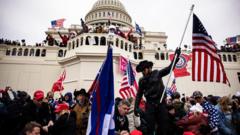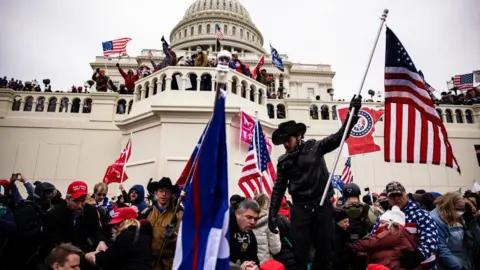This website uses cookies so that we can provide you with the best user experience possible. Cookie information is stored in your browser and performs functions such as recognising you when you return to our website and helping our team to understand which sections of the website you find most interesting and useful.

 Getty Images
Getty ImagesDonald Trump's alleged attempts to overturn his 2020 election defeat are laid out in a final report by the special counsel who spent two years investigating him.
Much of what is in its 140 pages was already known, thanks to a congressional inquiry in 2022 and previous court filings by the report author, Jack Smith.
But it sheds new light on some of the evidence uncovered by Smith's team and outlines his own thinking on some of the finer legal points.
Trump, who returns to the White House next week, took no time in responding to the report's release, maintaining his innocence and labelling Smith "deranged".
Here are five takeways from the report.
1. Trump encouraged violence, says Smith
The report addresses the riot at the US Capitol on 6 January 2021 - when Trump's supporters invaded the building to try to thwart the certification of Biden's win, after hearing a speech on the Ellipse in Washington DC by Trump, the defeated candidate.
"Mr Trump's words inspired his supporters to commit acts of physical violence," the report says.
It goes on to note: "Although Mr Trump at one point also told his supporters to 'peacefully and patriotically make [their] voices heard', he used the word 'fight' more than ten times in the speech."
Trump has vowed on his return to office to pardon many of those convicted of crimes related to the riot, which he has sought to recast as a "day of love".
His defenders have rejected the idea he deliberately incited the crowd, pointing to the "peaceful" quote highlighted by Smith above.
2. But he was not charged with incitement
The report addresses the basis on which Trump was prosecuted, making clear that Smith's team pondered bringing a charge of "incitement to insurrection" against the then-president.
The document says Trump's speech on the Ellipse on 6 January 2021 could meet the Supreme Court's definition of incitement, especially when seen alongside his "lengthy and deceitful voter-fraud narrative".
The report suggests that the day's violence was "foreseeable" to Trump, for example, and that he sought to "leverage" the events to delay Biden's certification.
But Trump was not ultimately accused of incitement because Smith's team did not find "direct evidence" of his intent to cause "the full scope of the violence" during the Capitol riot, making a conviction uncertain.
The document further notes that there were "other powerful charges available".
3. Rioters said they were there because of Trump's direction
Several men charged and convicted for their involvement in the Capitol attack pointed to Trump's influence as a motivating factor, the report says.
It quotes a few of the rioters including Alex Harkrider, who sought release from prison before his trial, by arguing that "like thousands of others" he was merely "responding to the entreaties" of Trump.
Another man, David Mehaffi, when seeking mitigation at sentencing, cited Trump's speech and added: "I trusted the president and that was a big mistake."
What Smith does not acknowledge in his report is that it was in these men's legal interests to shift responsibility away from themselves.
4. He pressed Mike Pence in vain for weeks
In repeated conversations, day after day, Trump asked his vice-president to use his ministerial position as president of the Senate to change the election outcome by not certifying the results, Smith's report lays out.
Pence refused, and on one occasion, Trump told him "hundreds of thousands" of people would "hate his guts" if he did not relent.
The pressure campaign on his deputy continued in public. In a speech, Trump said he hoped Pence would do it but if he did not, "I won't like him quite as much".
Just before he left the White House to give his speech at the Ellipse prior to the attack on the Capitol, Trump phoned Pence a final time, Smith says. When the vice-president told him on the call he did not have the authority to carry out Trump's wishes, Trump told staff to re-insert into his speech some language that he had drafted earlier targeting Pence.
Moments after the speech, Trump supporters were roaming the corridors of the Capitol chanting "hang Mike Pence", and hunting the offices for him.
5. Trauma of police officers recounted
Smith outlines the experiences of law enforcement on duty when the mob stormed the Capitol building, during which at least 140 officers were assaulted.
It points out that 123 defendants had subsequently been charged with using a deadly or dangerous weapon or causing serious bodily injury to law enforcement.
"This violence took a lasting toll," the report says, highlighting that 223 officers suffered "'unseen injuries', including depression and other forms of psychological trauma".
One footnote gives a further account of officers' feelings of "survivor's guilt", "shell-shock" and an "inability to move on from that day".




 Africana55 Radio
Africana55 Radio 

